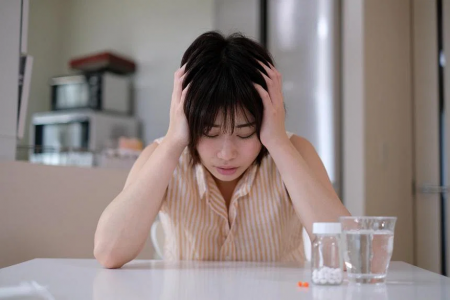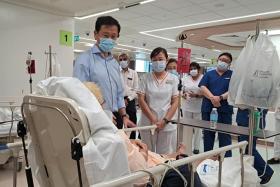Popping painkillers can make headaches worse, here’s what to do instead
A woman who suffered from chronic migraines for years sought medical help when the usual painkillers stopped alleviating her pain.
The solution turned out to be reducing the frequency of medication to only twice a week, says Dr Hew Jia Ni, family physician and clinical lead for Neurology Workgroup, SingHealth Polyclinics. The patient, who was in her 60s, had developed a medication-overuse headache.
People who pop painkillers for chronic headaches could end up aggravating their condition, say doctors The Straits Times spoke with.
Headaches are common worldwide, but not all headaches are easily resolved with over-the-counter medication. Here are five things to know about headaches and how to treat them.
1. What is a headache?
Almost everyone has had a headache or a pain in the head at some point in time, but there are different types of headaches based on cause and severity.
Headaches can be caused by stress or infection in the body, or arise in response to triggers such as exercise or sexual activity. Migraines are a more severe type of headache, and people with migraines suffer throbbing pain, sensitivity to light and loud sounds, and nausea or vomiting.
Dr Jonathan Ong, senior consultant at the National University Hospital’s (NUH) division of neurology, department of medicine, says headaches can be primary headaches, based on symptoms that occur with no underlying cause. Primary headaches include migraines, tension-type headaches and cluster headaches.
Secondary headaches are caused by underlying medical issues such as a head injury, stroke, infection, disorders of the neck, eyes, nose, sinuses or teeth.
“During a headache, multiple mechanisms activate specific nerves that affect muscles and blood vessels. These nerves send pain signals to the brain, leading to a perception of a headache,” says Dr Ong.
“For primary headaches, dysfunction or over-activity of pain-sensitive structures causes the headache,” he adds. “For secondary headaches, the pain is typically the result of stretching, dilatation, constriction or pain pathway stimulation within structures such as blood vessels, meninges, muscle fibres, facial structures, or cranial or spinal nerves, that leads to the perception of a headache.”
Medication-overuse headaches occur when people take painkillers frequently for at least three months. This includes taking paracetamol and non-steroidal anti-inflammatory drugs (NSAIDs) on 15 or more days a month, or taking migraine medication or opioids (such as codeine-based medicines) as well as combination painkillers on 10 or more days a month.
“This may lead to the development of tolerance, when the body becomes used to the drug so it stops being as effective. This can then lead to a process where the drugs are actually making your headaches worse and more frequent,” says Dr Ong.
2. 15 per cent of the world may have a headache right now
Headaches are among the most common disorders worldwide, according to the World Health Organisation (WHO) and the Global Burden of Disease (GBD) study by medical journal The Lancet.
The 2019 GBD study found that worldwide, migraine was the second most common cause of disability. The first was low back pain.
A 2022 paper in The Journal Of Headache And Pain noted that in 2019, each day, 15.8 per cent of the world’s population had a headache.
Dr Grace Huang, family physician at DTAP Clinic, sees up to five patients with headaches a week and says that primary and secondary headaches may present together.
“Headaches are a common painful and potentially disabling condition to have,” she adds.
3. Migraines cost singapore $1.04 billion in 2018
Mr Benjamin Loh, 26, has had migraines for half his life, starting when he was about 13. The staff nurse gets migraines about once every week or fortnight.
“The most common one I would describe as an intense, throbbing sensation in one or sometimes both sides of my head, starting at the crown and extending towards the temples and sometimes radiating towards the eyes,” he says. Occasionally, he feels like the room is spinning.
It is difficult to get work done when the migraine is bad, he adds.
A study released in 2019 by Duke-NUS Medical School and pharmaceutical company Novartis estimated that migraines cost Singapore $1.04 billion in 2018. About 80 per cent of this amount was because of lost productivity, and the rest was down to the costs of healthcare associated with managing migraines.
The study found that respondents missed 9.8 work days a year on average due to migraines, and for those who did go to work, the migraine affected their ability to carry out their tasks.
Dr Ong, lead author of that study, says the current best estimate of global migraine prevalence is 14 per cent to 15 per cent, and Singapore migraine statistics are comparable.
He adds that the NUH Neuroscience Clinic has seen a slight increase in the attendances of patients diagnosed with migraines over the last year.
4. Seek medical help for sudden or frequent headaches
While many headaches can be treated with over-the-counter medication, Dr Huang cautions that it might be prudent to see a doctor if you experience frequent headaches or develop an unusually severe headache.
She suggests taking note of any details associated with the onset of the headache, including triggers and the environment, as this can help the doctor make a diagnosis.
Dr Charles Siow, a neurologist with a clinic at Mount Elizabeth Novena Specialist Centre, recommends consulting a doctor for regular, disabling headaches, especially if they cause the person to miss work or school.
“If headaches come with symptoms such as weakness, slurred speech, numbness or dizziness or with fever, they need urgent medical attention. If headaches occur in an older patient above 50 or rapidly escalate in frequency and intensity, that is also a red flag,” he says.
Dr Hew says: “A headache may sometimes be the presentation of an underlying dangerous condition such as a stroke, brain bleed, tumour or infection.”
She adds that emergency medical attention could be required if the person suffers a sudden onset “thunderclap” headache that feels like the worst headache of his or her life; or for headaches that occur after head injury, or that present with symptoms such as severe vomiting, blurred vision, confusion, weakness, numbness or an unsteady gait.
5. ‘Smart’ ways to manage headaches
Dr Hew shares the “Smart” method with patients who suffer from headaches.
S - Sleep. Eight hours a day will help.
M - Meals. Eat regularly and do not skip meals. Stay hydrated.
A - Activity. Exercise regularly.
R - Relaxation. Do things you enjoy.
T - Triggers. Identify your triggers and avoid them.

Triggers differ from person to person. Dr Ong notes that caffeine may be a trigger for some patients, or may help others manage a headache.
He says steering clear of alcohol, getting plenty of rest and avoiding anything that could stress the body can also help when one has a headache.
He adds: “Pay attention to your posture and avoid prolonged screen time as they may lead to muscle strain in the neck and the eyes, which contributes to headaches.”
Get The New Paper on your phone with the free TNP app. Download from the Apple App Store or Google Play Store now


